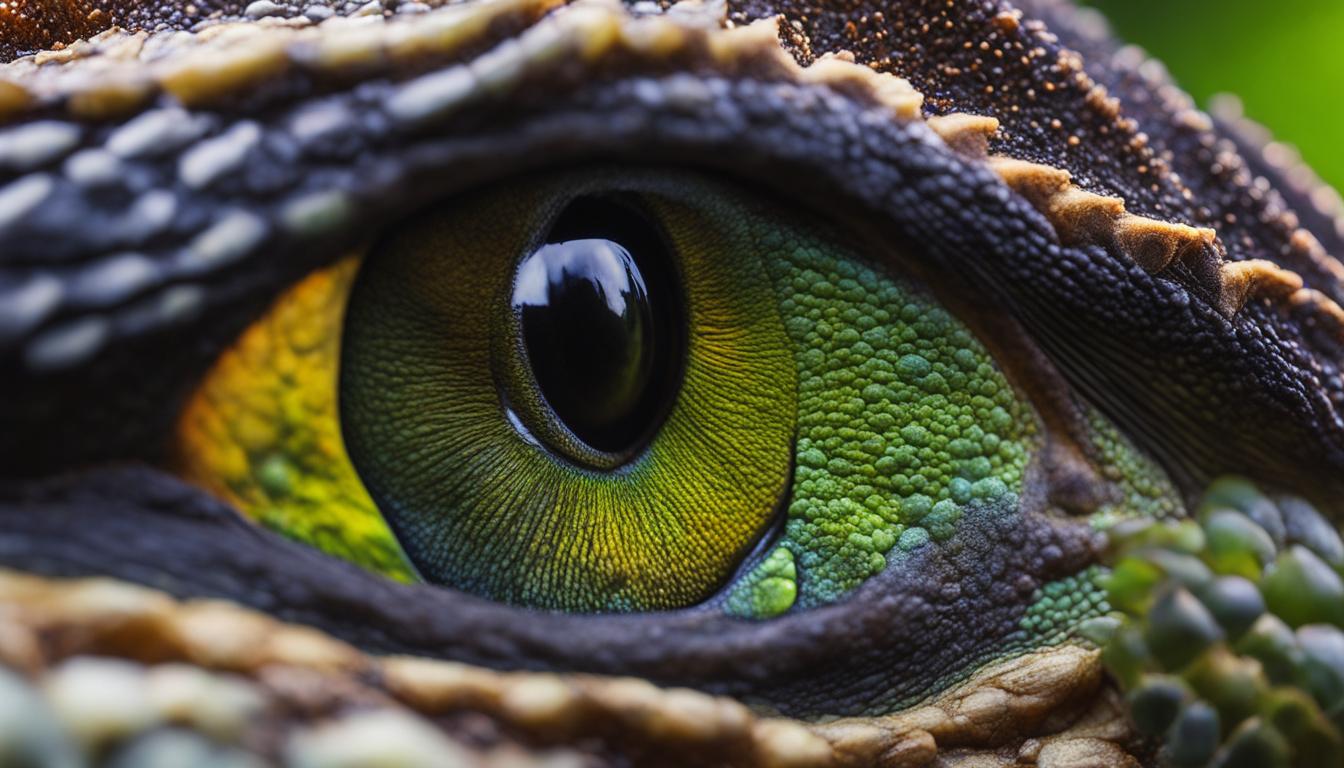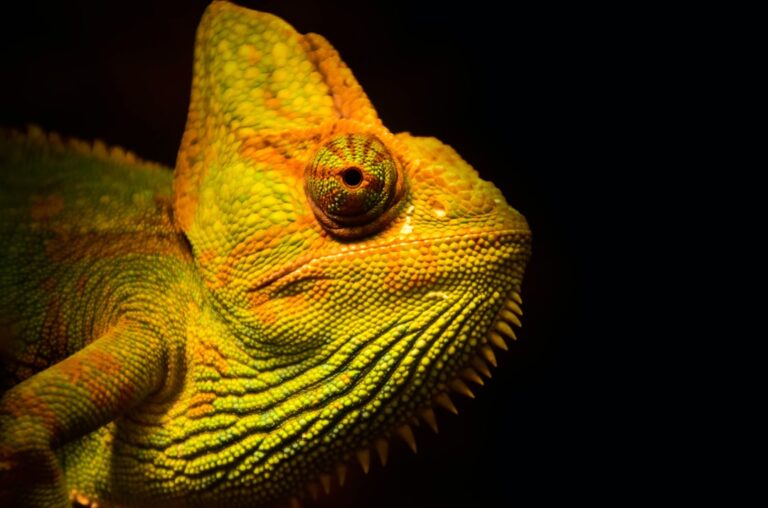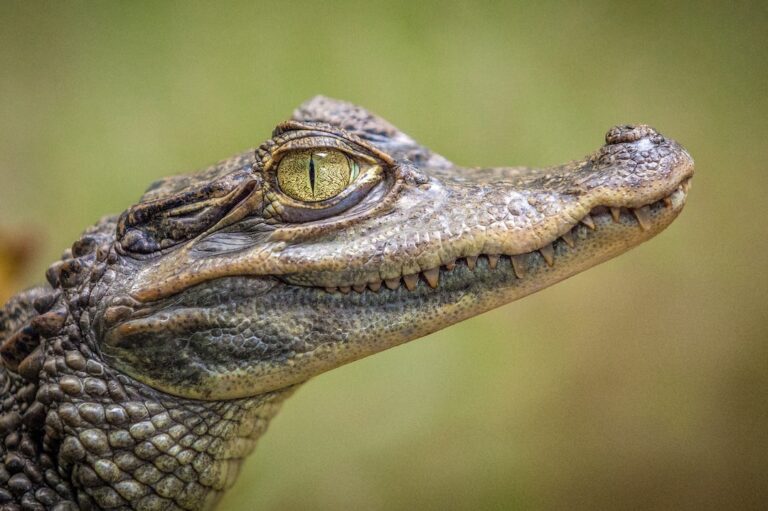Do Chameleons Blink?
Chameleons, with their ability to change colors and blend seamlessly into their surroundings, have long fascinated and intrigued us. But have you ever wondered if chameleons blink?
The answer might surprise you. Unlike humans and many other animals, chameleons do not have the ability to blink in the traditional sense. Their unique eye anatomy prevents them from closing their eyes completely, making blinking impossible. But fear not, chameleons have evolved alternative methods to keep their eyes clean and maintain good vision.
Let’s dive deeper into the fascinating world of chameleon eyes and explore the reasons behind their lack of blinking and the ingenious ways they take care of their remarkable vision.
Table of Contents
Key Takeaways:
- Chameleons have a unique eye anatomy that prevents them from blinking.
- Their fused eyelid structure does not allow for complete eye closure.
- Chameleons use alternative methods like the nictitating membrane, bulging technique, licking, and utilizing humidity and water to keep their eyes clean.
- UV light is crucial for chameleons’ eye health, and a balanced diet with sufficient vitamin A is essential for maintaining their vision.
- Chameleon owners should create proper habitat conditions and monitor their eye health to prevent eye infections and potential blindness.
Anatomy of a Chameleon’s Eye
Chameleons have fascinating eye anatomy that sets them apart from other animals. Let’s explore the unique features that make up a chameleon’s eye:
Unique Eyelid Structure
A chameleon’s upper and lower eyelids are fused together, forming a protective shield around their eyes. This fused structure allows only a narrow aperture for the eye to peer through, ensuring the chameleon’s vision remains sharp and focused. Unlike humans and many other creatures, chameleons do not have the ability to blink in the traditional sense.
Uncoupled Eye Movement and Vision
One intriguing aspect of a chameleon’s eye is its uncoupled movement. Unlike animals with binocular vision, chameleons can move their eyes independently. This means they can scan their surroundings without having to turn their heads, granting them a 360-degree view of their environment.
Scleral Ossicles and Visual Capability
Chameleons possess scleral ossicles, tiny bones embedded within the whites of their eyes. These ossicles provide structural support and allow for greater control over the shape of the eye. The ability to adjust the shape of the eye enhances a chameleon’s visual acuity, enabling them to focus on objects with incredible precision and accuracy.
| Unique Features of a Chameleon’s Eye | Benefits |
|---|---|
| Fused eyelid structure | Provides protection and helps maintain clear vision |
| Uncoupled eye movement | Allows for independent scanning of the surroundings |
| Scleral ossicles | Enhances visual capability and focus |
Understanding the Chameleon’s Blinking Mechanism
Chameleons have a fascinating anatomy that sets them apart from other animals, particularly when it comes to their eyes. Unlike humans and many other creatures, chameleons do not have a traditional blinking mechanism. This is due to their unique eyelid structure, which does not allow for complete eye closure as seen in other species.
Take a look at this image to see the intricate design of a chameleon’s eye:
Instead of blinking, chameleons have alternative methods to ensure the cleanliness and maintenance of their eyes. These mechanisms are essential for their overall eye health and well-being.
“Chameleons have a unique eyelid structure that prevents them from blinking.”
Let’s explore some of these fascinating methods in more detail in the following sections, as we delve further into the world of chameleon eye care.
The Process of Eye Cleaning in Chameleons
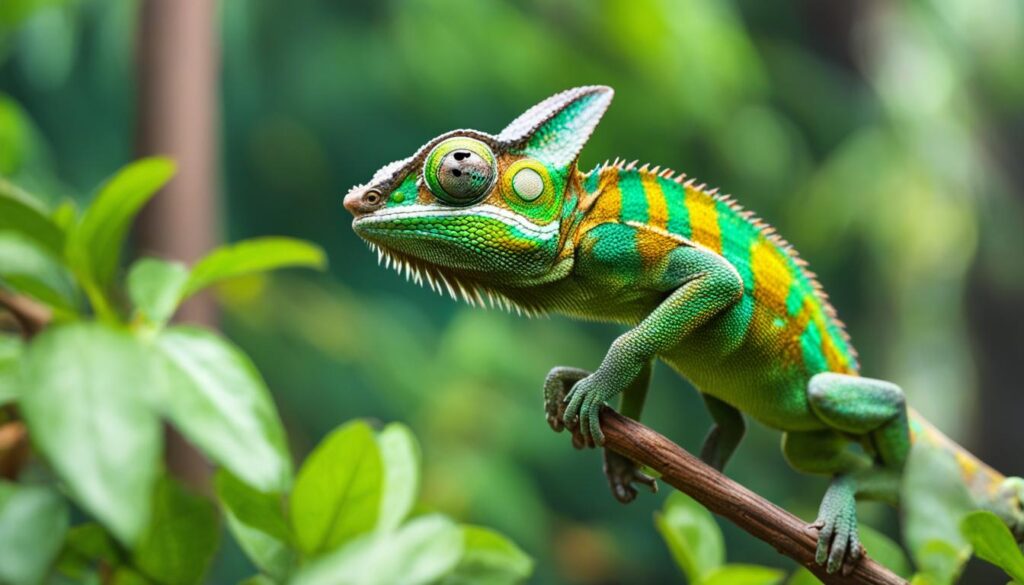
Chameleons have developed various methods to keep their eyes clean and maintain optimal eye health. These unique creatures have adapted to their environment, utilizing specialized techniques to ensure their visual capabilities remain sharp.
The Role of the Nictitating Membrane
One of the mechanisms chameleons use for eye cleaning is the nictitating membrane. This transparent inner eyelid serves as an additional protective layer over the eyes. It assists in cleaning and prevents irritants from entering the eyes while still allowing enough light for clear vision.
Self-Cleaning Eyes: A Bulging Technique
Chameleons also possess a self-cleaning ability through a unique bulging technique. They actively push their eyeballs against their eyelids, which helps remove any debris that may have accumulated on the eyes’ surface. This bulging action assists in keeping their eyes clear and minimizes the risk of potential irritations.
Licking Their Eyes Clean
In addition to the nictitating membrane and the bulging technique, chameleons have another unusual method for eye cleaning – licking. With their long, agile tongues, chameleons can lick their eyes to remove any remaining dirt or particles. This action aids in maintaining clean and clear vision.
Utilizing Humidity and Water
Chameleons also take advantage of their habitat’s humidity and water sources for eye cleaning. High humidity levels can help keep their eyes moist, preventing dryness and discomfort. Furthermore, they may utilize water droplets or rain to remove any foreign substances from their eyes, ensuring optimal eye health.
By employing a combination of the nictitating membrane, the bulging technique, licking, and utilizing humidity and water, chameleons have an effective arsenal for keeping their eyes clean and free from irritants. These remarkable adaptations contribute to their overall eye health and the maintenance of their exceptional vision.
Do Chameleons Blink?
Chameleons do not blink like humans or other animals due to their fused eyelid structure. Instead, they have alternative methods to clean and maintain their eyes.
Chameleons have a unique eye anatomy that sets them apart from other creatures. Their upper and lower eyelids are fused together, creating a narrow aperture for their eyes to peer through. This fused eyelid structure prevents them from blinking in the traditional sense. However, chameleons have evolved other mechanisms to keep their eyes clean and maintain optimal vision.
Instead of blinking, chameleons utilize various techniques to ensure eye hygiene. They have a nictitating membrane, a transparent eyelid-like structure, that helps protect and cleanse their eyes. They can also employ a bulging technique where they push their eyeballs against their eyelids to remove debris and irritants. Additionally, chameleons have long tongues that they can use to lick their eyes and keep them clean.
While chameleons may not blink conventionally, their eye-cleaning mechanisms and unique eye anatomy enable them to maintain good eye health and clear vision.
Can Chameleons Close Their Eyes?
While chameleons cannot blink like humans, they do have the ability to partially close their eyes. This is made possible by their unique fused eyelids, which allow only a small slit to expose the pupil. While their eyes may not close completely, this partial closure serves multiple purposes for chameleons.
Firstly, the small slit of exposed pupil helps chameleons maintain their vision. By partially closing their eyes, they can regulate the amount of light entering their eyes, preventing excessive brightness from affecting their visual clarity. This adaptation is especially advantageous for chameleons as they frequently move between different light conditions in their natural habitats.
Secondly, the partial closure of their eyes provides a certain level of protection. While chameleons do not have the ability to blink and fully seal their eyes, the fused eyelids serve as a barrier against potential hazards such as dust, debris, and foreign objects. The narrow opening created by the partially closed eyelids reduces the risk of these substances directly entering the eyes and causing irritation or damage.
It is important to note that even though chameleons can partially close their eyes, their eye-cleaning mechanisms still play a vital role in maintaining eye health. They rely on alternative methods, such as the nictitating membrane and the bulging technique, to keep their eyes clean and free from irritants.
Protection and Maintenance of Chameleon’s Vision
Chameleons have unique visual abilities that require specific factors for the protection and maintenance of their vision. Two crucial aspects to consider are the importance of UV light and the impact of diet, specifically vitamin A, on their eye health.
The Importance of UV Light
UV light plays a crucial role in chameleons’ eye health and overall vision. These remarkable reptiles rely on UV light to see colors and patterns in their surroundings. Exposure to UV light allows them to accurately assess their environment and detect potential threats or prey. It is essential to provide chameleons with appropriate UV lighting in their habitat to ensure optimal eye health and maintain their natural UV perception.
Diet’s Impact on Eye Health: Vitamin A
A balanced diet is vital for maintaining chameleons’ eye health, and vitamin A plays a significant role in achieving this. Vitamin A is essential for maintaining the health of the retina and other structures within the eyes. It promotes good vision, prevents dryness and irritation, and aids in preventing eye-related conditions that could impact chameleons’ overall well-being.
Chameleons obtain vitamin A through their diet, particularly from consuming insects such as crickets and mealworms. It is important to ensure that their diet provides an adequate amount of vitamin A to support their eye health. A deficiency in vitamin A can lead to eye problems, including reduced visual acuity and increased susceptibility to infections. Providing a varied and nutrient-rich diet is crucial for chameleons’ overall eye health and vitality.
Importance of UV Light and Diet for Chameleon’s Eye Health
| UV Light | Diet: Vitamin A | |
|---|---|---|
| Role | Enables color perception and pattern detection | Maintains retinal health and good vision |
| Source | Natural UV light in the environment | Insects such as crickets and mealworms |
| Effects of Deficiency | Reduced visual acuity and compromised eye health | Increased susceptibility to eye infections and dryness |
| Importance for Chameleon | Essential for accurate assessment of surroundings and survival | Supports overall eye health and prevents eye-related conditions |
Common Eye Conditions in Chameleons
Chameleons are fascinating creatures with unique eye anatomy. However, like any living being, they are susceptible to various eye conditions that can affect their health and well-being. In this section, we will explore three common eye conditions in chameleons: conjunctivitis, hypovitaminosis A, and trauma, as well as the importance of injury prevention.
Conjunctivitis: Causes and Treatment
Conjunctivitis, also known as “pink eye,” is a common eye infection that affects chameleons. Bacterial infections are often the cause of conjunctivitis and can lead to symptoms such as redness, swelling, discharge, and difficulty in feeding. If you notice any signs of conjunctivitis in your chameleon, it is essential to seek veterinary care promptly.
Treatment for conjunctivitis in chameleons typically involves the administration of antibiotics to combat the bacterial infection. Additionally, the veterinarian may recommend supportive care, such as cleaning the eyes with a saline solution and applying antibiotic ointments. It is crucial to follow the veterinarian’s instructions closely to ensure the best possible outcome for your chameleon.
Hypovitaminosis A: Diet Deficiency Effects
Hypovitaminosis A is a condition that arises from a deficiency in vitamin A, an essential nutrient for chameleons’ eye health. When chameleons do not receive an adequate amount of vitamin A in their diet, it can lead to a variety of health issues, including swelling of the eyelids.
To prevent hypovitaminosis A in chameleons, it is vital to provide a well-balanced diet that includes foods rich in vitamin A. Leafy greens, carrots, and other colorful vegetables can help ensure your chameleon receives an adequate vitamin A intake. However, it is essential to consult with a reptile veterinarian or herpetologist to establish a proper diet plan for your chameleon’s specific needs.
Trauma and Injury Prevention
Chameleons’ eyes are delicate, and trauma to the eyes can cause severe damage and even blindness. It is crucial to take proactive measures to prevent injuries to your chameleon’s eyes. Here are some tips for trauma and injury prevention:
- Avoid handling your chameleon excessively and with rough movements.
- Ensure that the enclosure is free from sharp objects or decorations that could potentially injure the eyes.
- Provide adequate space within the enclosure to allow for natural movement and minimize the risk of accidental trauma.
- Regularly inspect the enclosure for any potential hazards and address them promptly.
- Consult with a reptile veterinarian or herpetologist for additional guidance on injury prevention and maintaining a safe environment for your chameleon.
By being proactive in preventing trauma and injuries, you can help safeguard your chameleon’s eye health and overall well-being.
Implications of Not Blinking for Chameleons
The inability of chameleons to blink has significant implications for their eye health. Unlike humans and many other animals, chameleons lack the ability to perform the instinctive action of blinking to moisten and cleanse their eyes. As a result, they must rely on alternative mechanisms to keep their eyes clean and maintain optimal vision.
Without the natural blinking mechanism, chameleons are more susceptible to eye conditions and potential blindness. Failure to effectively clean their eyes can lead to the accumulation of debris, irritants, and bacteria, which can cause infections and other eye-related problems. Additionally, the absence of blinking may disrupt the natural lubrication of the eyes, leading to dryness and discomfort.
To compensate for the lack of blinking, chameleons have developed alternative methods to ensure their eyes remain clean and their vision is preserved. These mechanisms include:
- Utilizing the nictitating membrane: Chameleons have a transparent membrane, known as the nictitating membrane, which acts as an extra protective layer for their eyes. The membrane helps remove debris and foreign particles that may come into contact with the eyes.
- Engaging in a bulging technique: Chameleons can push their eyeballs against their eyelids, causing a bulging effect. This action helps to mechanically clean the eyes and remove any potential irritants or debris.
- Licking their eyes: Chameleons possess long tongues that they can use to lick their eyes. This licking action aids in the process of eye cleaning and helps keep the eyes moist.
- Utilizing humidity and water: Chameleons can take advantage of their environment’s humidity and water sources to keep their eyes hydrated and cleanse them.
By employing these alternative mechanisms, chameleons can mitigate some of the implications of not blinking. However, it is essential for chameleon owners to be vigilant in monitoring their pets’ eye health and ensuring regular maintenance. Neglecting proper eye care can result in the development of eye conditions, diminished vision, and potential harm to the chameleon’s overall well-being.
Behavioral Responses to Eye Irritation in Chameleons
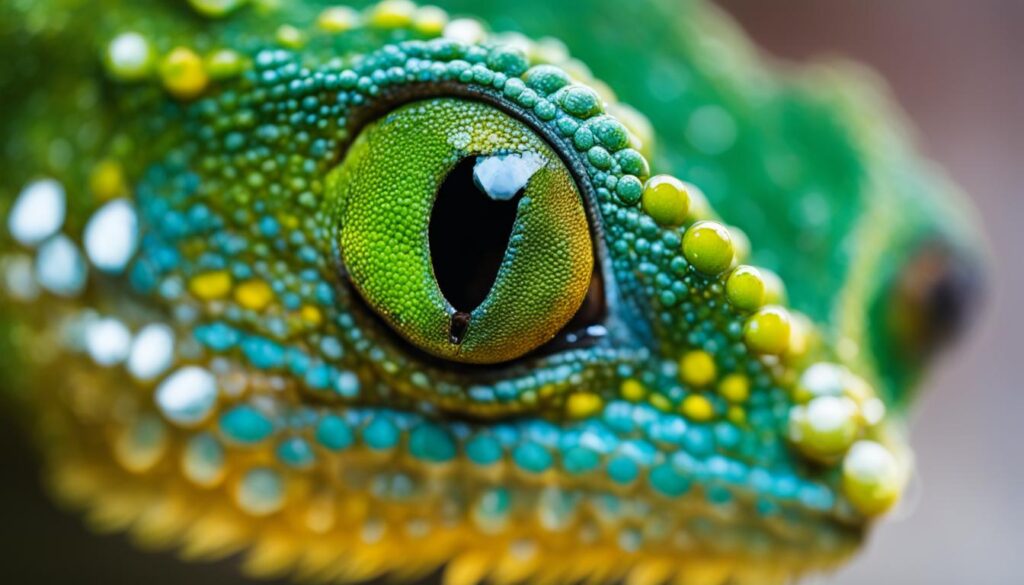
Chameleons, like all creatures, can experience eye irritation. When this occurs, they exhibit specific behavioral responses to alleviate the discomfort. One common behavior is rubbing their eyes against objects in their environment. By rubbing their eyes, chameleons attempt to relieve the irritation they are feeling.
However, it is important to note that this behavior can pose risks to their eye health. Excessive rubbing can lead to eye damage and potentially result in infections. Chameleons’ eyes are delicate and must be properly cared for to avoid complications.
Proper eye care for chameleons involves ensuring a clean and safe environment. Removing any potential irritants from their enclosure can help prevent eye irritation. Additionally, maintaining appropriate humidity levels and providing fresh water enables chameleons to keep their eyes clean and moisturized.
Regular monitoring of chameleon’s eye health is crucial. If you notice any signs of persistent eye irritation or inflammation, it is recommended to consult a veterinarian who specializes in reptile care. They can provide guidance and treatment to help alleviate any discomfort and keep your chameleon’s eyes healthy.
Ensuring Healthy Eyes in Your Chameleon
To keep your chameleon in the best possible health, it’s important to pay special attention to their eyes. By creating the proper habitat conditions, monitoring their eye health, and providing veterinary care when necessary, you can ensure that your chameleon maintains healthy eyes and prevents blindness.
Creating the Proper Habitat Conditions
Creating the right habitat conditions is essential for promoting healthy eyes in your chameleon. Here are some key factors to consider:
- UV Light Exposure: Chameleons require proper UV light exposure to support their eye health. Ensure that their enclosure has appropriate UVB lighting to provide the necessary UV rays for their eyes.
- Humidity Levels: Chameleons also need the right humidity levels to keep their eyes moisturized. Maintain the appropriate humidity range based on the species of chameleon you have.
By ensuring the right habitat conditions, you can help your chameleon maintain healthy eyes and reduce the risk of eye-related issues.
Signs of Eye Infections and Veterinary Care
Regular monitoring of your chameleon’s eyes is essential for detecting any signs of eye infections. Some common symptoms of eye infections include:
- Redness or swelling around the eyes
- Discharge or excessive tearing
- Clouding or opacity in the eyes
- Behavioral changes such as rubbing or scratching at the eyes
If you notice any of these signs, it’s crucial to seek veterinary care promptly. A veterinarian experienced in reptile care can provide the appropriate diagnosis and treatment to address the infection and prevent further complications.
Monitoring Eye Health: Preventing Blindness
To prevent blindness and ensure optimal eye health in your chameleon, regular monitoring is key. Here are some important monitoring practices to implement:
- Observe your chameleon’s eyes regularly, looking for any changes in appearance or behavior.
- Monitor the cleanliness of their eyes, checking for any debris or signs of irritation.
- Keep track of their feeding habits and overall behavior, as changes in appetite or activity levels can indicate potential eye issues.
By being vigilant and proactive in monitoring your chameleon’s eye health, you can catch any problems early and take appropriate action to prevent blindness.
Remember, healthy eyes are essential for your chameleon’s overall well-being. By creating the proper habitat conditions, monitoring their eye health, and seeking veterinary care when needed, you can ensure that your chameleon enjoys a lifetime of healthy vision.
Conclusion
Chameleons have a fascinating eye anatomy that sets them apart from other animals. Unlike humans and many other species, chameleons cannot blink due to their unique eyelid structure. Their upper and lower eyelids are fused together, creating only a small opening for their eyes to peer through. As a result, chameleons have developed alternative methods to clean and maintain their eyes.
Understanding the intricacies of chameleon eye anatomy is key to ensuring their eye health. Providing the right habitat conditions, such as proper UV light exposure and humidity levels, is crucial for maintaining good eye health. Regular monitoring of their eyes and recognizing any signs of eye infections is essential for early intervention and veterinary care.
By implementing proper eye care measures, chameleon owners can help prevent eye conditions and maintain their pets’ overall well-being. While chameleons may not blink like humans, their unique adaptations and mechanisms allow them to keep their eyes clean and maintain good vision. So, be sure to prioritize eye health when caring for these remarkable creatures.
FAQ
Do chameleons blink?
No, chameleons do not blink like humans or other animals due to their unique eyelid structure. However, they have alternative methods to clean and maintain their eyes.
What is the anatomy of a chameleon’s eye?
Chameleons have a unique eyelid structure, uncoupled eye movement, and scleral ossicles, which contribute to their visual capabilities.
How do chameleons clean their eyes?
Chameleons have various methods for eye cleaning, including using a transparent membrane called the nictitating membrane, a bulging technique, licking their eyes, and utilizing humidity and water.
Can chameleons close their eyes?
While chameleons cannot blink, they can partially close their eyes to expose the pupil while still providing some protection.
How is the chameleon’s vision protected and maintained?
UV light is important for their eye health, and a balanced diet that includes sufficient vitamin A is crucial. These factors help maintain their vision and prevent eye-related conditions.
What are some common eye conditions in chameleons?
Conjunctivitis, hypovitaminosis A, trauma, and injury prevention are important considerations for maintaining chameleons’ eye health.
What are the implications of not blinking for chameleons?
Chameleons need to rely on alternative mechanisms to keep their eyes clean and maintain good vision. Failure to do so can result in eye conditions and potential blindness.
How do chameleons respond to eye irritation?
Chameleons may exhibit specific behaviors like rubbing their eyes against objects, but this can pose a risk of eye damage and infection. Proper eye care is crucial to prevent such issues.
How can I ensure healthy eyes in my chameleon?
Creating the proper habitat conditions, recognizing signs of eye infections, and monitoring their eye health are essential for maintaining your chameleon’s eye health and preventing blindness.
Is blinking necessary for chameleons?
No, chameleons have a unique eye anatomy that prevents them from blinking. Instead, they have developed alternative methods to clean and maintain their eyes.
Can chameleons adjust their eyelid movement to protect their eyes from external factors?
Chameleons have a fused eyelid structure that limits their ability to adjust their eyelid movement. However, they have other mechanisms, such as the nictitating membrane and bulging technique, to protect their eyes.
How can I prevent eye infections in chameleons?
Providing the proper habitat conditions, regular monitoring of their eyes, and seeking veterinary care at the first sign of infection can help prevent eye infections in chameleons.
What should I do if my chameleon shows signs of eye irritation or discomfort?
If your chameleon exhibits signs of eye irritation or discomfort, it is important to consult with a veterinarian who specializes in reptile care for proper diagnosis and treatment.
Are there any specific eye care products for chameleons?
There are no specific eye care products made exclusively for chameleons. However, maintaining the proper habitat conditions and seeking veterinary care when needed can help ensure their eye health.

